Can Carbon Farming Help Save the Outback?
In Western Australia, pastoral lease reform raises hopes for people and their land
Authors: Pepe Clarke & David Mackenzie | Published: June 18, 2018
In the Outback of Western Australia, pastoral leaseholders have for years faced a tough choice: Graze livestock in an unsustainable and land-damaging way, or go easy on the land while sliding toward financial hardship.
That’s because the Western Australia pastoral lease system, which covers one-third of the state and an area bigger than Texas, historically restricted leaseholders to grazing livestock as their primary business, even though degraded land has rendered grazing unprofitable in many areas. As a result, a growing number of Western Australians have chosen a third option—leaving the region—just at a time when the Outback needs more occupants, not fewer, to prevent the spread of feral animals, noxious weeds, and uncontrolled wildfires.
In an effort to reverse that trend and help repair the landscape, the Western Australian government in April began allowing a new line of business—carbon farming—on lands once reserved for grazing. Carbon farming, which essentially means working the land in a way that maximizes the amount of carbon dioxide stored in the native vegetation and soil, is a way for landowners to gain carbon credits that they can then sell to companies seeking to offset their emissions.

